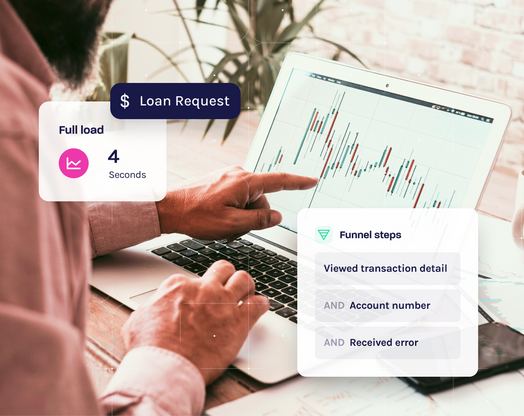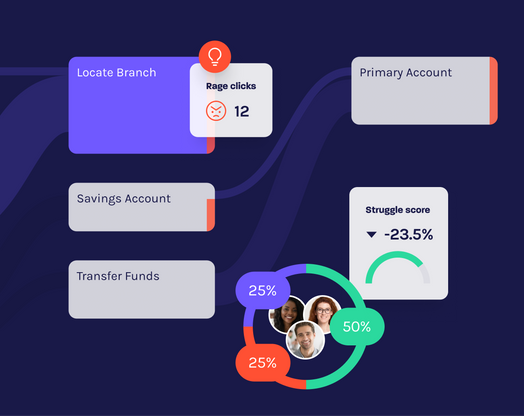
Web performance benchmarks from the world's leading brands
Speed has a significant impact on customer experience—but you’re not just racing against direct competitors. When customers can stock up on groceries in minutes while binging a new Netflix series, expectations for lightning-fast experiences inevitably follow from their personal lives into business interactions. Think about it:
53% of visitors will abandon any site that takes longer than three seconds to load
Bounce rates increase by 123% if a site takes longer than one second to load
A 100-millisecond delay in load time can hurt conversion rates by 7%
Slow-loading websites cost business owners nearly $7 billion per year
Now, you may not be competing with Amazon or Instacart, but—like it or not—they’ve set the bar for what fast and frictionless experiences actually look like. That’s why it’s critical to keep on top of these behemoths and how they’re performing. In this post, we’re taking a closer look at some of the world’s largest companies to uncover:
Who’s winning in the race to provide an optimal web experience—based on critical web performance benchmarks
Who’s falling behind—and why
Impactful performance improvements to prioritize
Let’s dive in!
Methodology
We used Glassbox’s Web Performance Index to compare web performance of enterprise organizations (more than 1,000 employees) across the automotive, finance, technology, telecommunication, travel and retail industries. Each company has a total score out of 100, determined by the following speed-related performance metrics:
First Contentful Paint (FCP): FCP measures how quickly a browser renders the first element on a webpage, such as text or an image. This can significantly impact a user’s perception of website speed.
Time to First Byte (TTFB): TTFB measures how long it takes for the browser to receive its first byte of information after making a request to the server (i.e. a user clicking a button or attempting to navigate to a new page).
Largest Contentful Paint (LCP): LCP measures the loading time for the largest piece of content—typically an image or video.
Total Blocking Time (TBT): TBT measures how long a page is blocked from responding to user input like clicks, taps or swipes.
Time to Interactive (TTI): TTI measures the amount of time for a webpage to become fully interactive and responsive to user input.
Interaction to Next Paint (INP): INP measures a web page’s response time to user input.
Findings
Note: The Web Performance Index is based on averages for the previous month, and is accurate at the time of publishing. For ease of comparison, all time is measured in milliseconds.
Top performers
Google was the top performer in every category and the only organization to receive a perfect score. Orange, TripAdvisor, BMW, Amazon and JPMorgan Chase followed with the fastest websites in their respective industries.
In some cases, companies outperformed those with a higher overall score. Amazon, for example, had the second fastest First Contentful Paint, Time to First Byte and Largest Contentful Paint. However, its Total Blocking Time and Time to Interactive were disproportionately slower, which ultimately pulled Amazon down to position #5 out of six. Amazon likely suffered from the vast number of products loading at any given time.
The correlation between type of website and loading times is also evident with BMW, whose high-definition images and interactive “build your own BMW” tool resulted in the slowest times for first and largest contentful paint among the top six. However, it was still significantly faster than any website on the worst performers list, which demonstrates that even media-rich websites can be optimized for speed.
Worst performers
Hyundai, China Construction Bank, Microsoft, NTT, Kroger and AMEX Travel had the slowest websites in their industry, with notable gaps between top performers on Largest Contentful Paint and Time to Interactive.
AMEX Travel, which had the lowest overall score, actually outperformed on First Contentful Paint and Time to First Byte and ranked third for Total Blocking Time. However, it was dead last on Largest Contentful Paint and Time to Interactive, which ultimately landed it at the bottom of the list. Kroger similarly suffered from slow times on Largest Contentful Paint and Time to Interactive, in spite of being significantly faster on First Contentful Paint and Time to First Byte.
Microsoft accomplished a faster Total Blocking Time than multiple companies on the top performers list, including Orange, Amazon and JPMorgan, but had exorbitantly high times for First Contentful Paint, Largest Contentful Paint, Time to First Byte and Time to Interactions. The biggest advantage of breaking down and comparing website performance across several metrics is that it gives you the opportunity to laser focus on areas for improvement.

Web performance improvements
Interestingly, top and bottom performers struggled and succeeded with the same metrics. Interaction to Next Paint (INP), Total Blocking Time (TBT) and Time to First Byte (TTFB) had the fastest times in both cohorts, while Time to Interactive (TTI), Largest Contentful Paint (LCP) and First Contentful Paint (FCP) were the biggest opportunities for improvement.

If you’ve noticed similar trends in your own web performance metrics, the good news is you can simultaneously optimize Time to Interactive, Largest Contentful Paint and First Contentful Paint. Some of the more common improvements include:
Combining JavaScript and CSS, minifying code and cutting down on external scripts to limit http requests
Differing non-critical CSS to reduce render-blocking resources
Minimizing image and video file sizes
Enabling lazy load to only load content when necessary (i.e. a user scrolls to a particular image)
Leveraging a content delivery network (CDN) to respond to users faster
Back to you
In the instant gratification era, speedy websites are table stakes. You don’t have to go head to head with Google or Amazon, but you do need to deliver fast, frictionless experiences your customers have come to expect. Examining performance metrics from leading organizations will help identify which areas you can optimize to deliver a similar gold standard experience—and edge out your competitors in the process.
See how your website stacks up with Glassbox’s Web Performance Index tool.







